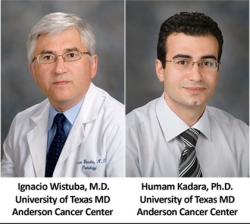


Posted November 25, 2015
Ignacio Wistuba, M.D., and Humam Kadara, Ph.D., The University of Texas MD Anderson Cancer Center
 Lung cancer is the leading cause of cancer-related deaths in the United States and worldwide. Approximately 85% of lung cancer cases are classified as Non-Small Cell Lung Cancer (NSCLC). Lung adenocarcinomas and squamous cell carcinomas are the most frequently diagnosed histological subtypes of NSCLC. Even when NSCLC patients are diagnosed early at Stage I, patients only have a five-year survival rate of approximately 50%. These statistics indicate a serious unmet need for therapeutic options in the treatment of NSCLC.
Lung cancer is the leading cause of cancer-related deaths in the United States and worldwide. Approximately 85% of lung cancer cases are classified as Non-Small Cell Lung Cancer (NSCLC). Lung adenocarcinomas and squamous cell carcinomas are the most frequently diagnosed histological subtypes of NSCLC. Even when NSCLC patients are diagnosed early at Stage I, patients only have a five-year survival rate of approximately 50%. These statistics indicate a serious unmet need for therapeutic options in the treatment of NSCLC.
Funded by a Fiscal Year 2009 LCRP Collaborative Research Award, Drs. Humam Kadara and Ignacio Wistuba, from the University of Texas M.D. Anderson Cancer Center, sought to investigate the genetic changes that contribute to the development of NSCLC after smoking-induced damage. Through in situ hybridization analysis of tissue microarrays from 368 NSCLC specimens, Dr. Kadara and his collaborators demonstrated that the lysosomal transmembrane protein 4 beta (LAPTM4B) gene is expressed at higher levels in NSCLC tumor cells, as well as in the airway cells closest to tumors, as compared with normal lung tissue. In vitro studies using NSCLC specimens indicated that LAPTM4B promotes anchorage-independent growth of lung cancer cells, demonstrating the potential to metastasize and invade other organs. They also discovered that elevated levels of LAPTM4B were found more predominantly in lung adenocarcinomas of former or current smokers and the higher levels were associated with poor patient prognosis. Generally, LAPTM4B appears to protect cells from starvation-induced stress, promote cellular autophagy, an adaptive response that promotes cell survival, and activate NRF2, a protein that activates expression of anti-oxidant genes in response to cellular stress.
Understanding the molecular mechanisms of cancer cell growth is critical to development of new therapeutics and reducing lung-cancer related deaths. Under his LCRP award, Drs. Kadara and Wistuba have successfully defined a new mechanism for lung cancer cell growth and persistence. Early detection of cancer is vital to increasing survival rates, and these results suggest LAPTM4B may be a biomarker for early detection of aggressive lung cancers. Thus, the findings from this research have the potential to improve both therapeutics and diagnostics, dramatically reducing lung cancer related deaths.
Publication:
Maki Y, Fujimoto J, Lang W, et al. 2015. LAPTM4B is associated with poor prognosis in NSCLC and promotes the NRF2-mediated stress response pathway in lung cancer cells. Sci Rep 5:13846. doi: 10.1038/srep13846.
Links:














